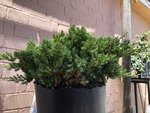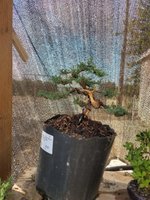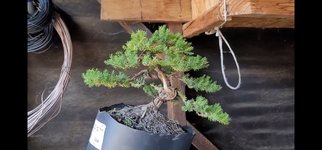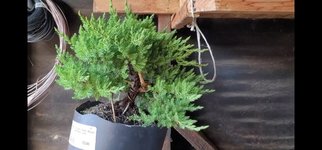You are using an out of date browser. It may not display this or other websites correctly.
You should upgrade or use an alternative browser.
You should upgrade or use an alternative browser.
5 gallon Juniper nana practice what yall think?
- Thread starter BoostedBonsai
- Start date
Quince
Mame
Looks like you found a nice once with smooth taper in the first few inches. The wire would be more effective if you wrapped it to support the outside of the curve.
BoostedBonsai
Mame
Looks like you found a nice once with smooth taper in the first few inches. The wire would be more effective if you wrapped it to support the outside of the curve.
ahh yeah i needa get a hang of that
BoostedBonsai
Mame
Leo in N E Illinois
The Professor
- Messages
- 11,341
- Reaction score
- 23,294
- USDA Zone
- 5b
When a tree is in early phases of training, it is not unusual to change opinion on where the front and back are. This happens often.
Nice start.
Nice start.
BoostedBonsai
Mame
yeah I've been learning that lol thanks!When a tree is in early phases of training, it is not unusual to change opinion on where the front and back are. This happens often.
Nice start.
BoostedBonsai
Mame
Tieball
Masterpiece
Eventually you’ll need to take on some root work. Not right now though. You have a great looking smaller tree…learn a lot about the roots before you go chopping roots.
Dont let those surface level roots dry out yet.
Regardless of the future root work…..you have an excellent start and you’re comfortable making some moves and changes. Mighty fine!
Dont let those surface level roots dry out yet.
Regardless of the future root work…..you have an excellent start and you’re comfortable making some moves and changes. Mighty fine!
BoostedBonsai
Mame
Eventually you’ll need to take on some root work. Not right now though. You have a great looking smaller tree…learn a lot about the roots before you go chopping roots.
Dont let those surface level roots dry out yet.
Regardless of the future root work…..you have an excellent start and you’re comfortable making some moves and changes. Mighty fine!
yess sir come winter this will get root worked although I'm afraid the top roots are dry already maybe but will make the best of it
and yah bro can't be scared in life or u won't get nowhere lol
Tieball
Masterpiece
You’ll tackle it all just fine. A great California characteristic!yess sir come winter this will get root worked although I'm afraid the top roots are dry already maybe but will make the best of it
and yah bro can't be scared in life or u won't get nowhere lol
I'd probably water and cover the top roots anyway. Just in case there’s a survival that happens. Next tree….keep the roots covered. Hopefully on this tree there are plenty of finer roots like those air dried on top right now below the soil surface.
just.wing.it
Deadwood Head
Nice work so far! Looks great.
Forsoothe!
Imperial Masterpiece
An important concept of wiring 101 strategy is that the wire needs to be stretched tighter as the result of the bending that you do, and not loosened by your actions. That is accomplished by considering which way you intend to move the branch before you put the wire on it, and then backtrack mentally so you can start wrapping from the right place and in the right direction so that the wire crosses the branch at the right point and from the right direction.
If you intend to move a branch up, then the wire has to be anchored below that point for at least one 360° wrap and pass over the top of the branch at its starting point: you move the branch up and that stretches the wire making it tighter and holding better. If you intend to move the branch down the wire is anchored above the branch for at least one whole circumference and passes under the branch at its starting point. Left and right follow the same rule.
Supporting the crotch of the branch is also important. The first loop should be close the trunk 360°, then begin the 45° wrap outbound. 45° is important because you want the maximum resistance of the wire to be applied against your bending it. That first 360° loop tight to the trunk supports the branch and distributes the load of the bend to the branch so that the main force is not applied at the crotch of the branch/trunk union. This is more important in some cases rather than all, but it is a good practice that will help you break fewer branches off right at the trunk. (Some breaks can be re-set and encased in wound sealer and still live, but not at the point they emerge from the trunk. Those broken branches can never be bent again because that will always be a weak point.) If the wire ran at 90° to the branch, straight up and down, it offers no resistance to bending along the axis of the branch. If the wire runs a zero°, in parallel to the branch, again it offers little or no resistance to bending (or holding). Half way between the two, 45° offers maximum available resistance and holding power. Any angle that is more or less just has less holding power.
This wire is the KEY(my word, not the official term), the 360° loop supporting the base of the branch. The anchor point has to be lower so that the KEY can be wrapped couterclockwise and laid at the right place and angle to bend the trunk down and to the right and/or forward. If the trunk was to be bent down and to the rear, it would be wound clockwise. Once you understand this everything will fall into place.
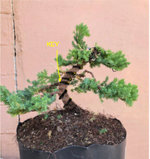
If you intend to move a branch up, then the wire has to be anchored below that point for at least one 360° wrap and pass over the top of the branch at its starting point: you move the branch up and that stretches the wire making it tighter and holding better. If you intend to move the branch down the wire is anchored above the branch for at least one whole circumference and passes under the branch at its starting point. Left and right follow the same rule.
Supporting the crotch of the branch is also important. The first loop should be close the trunk 360°, then begin the 45° wrap outbound. 45° is important because you want the maximum resistance of the wire to be applied against your bending it. That first 360° loop tight to the trunk supports the branch and distributes the load of the bend to the branch so that the main force is not applied at the crotch of the branch/trunk union. This is more important in some cases rather than all, but it is a good practice that will help you break fewer branches off right at the trunk. (Some breaks can be re-set and encased in wound sealer and still live, but not at the point they emerge from the trunk. Those broken branches can never be bent again because that will always be a weak point.) If the wire ran at 90° to the branch, straight up and down, it offers no resistance to bending along the axis of the branch. If the wire runs a zero°, in parallel to the branch, again it offers little or no resistance to bending (or holding). Half way between the two, 45° offers maximum available resistance and holding power. Any angle that is more or less just has less holding power.
This wire is the KEY(my word, not the official term), the 360° loop supporting the base of the branch. The anchor point has to be lower so that the KEY can be wrapped couterclockwise and laid at the right place and angle to bend the trunk down and to the right and/or forward. If the trunk was to be bent down and to the rear, it would be wound clockwise. Once you understand this everything will fall into place.

BoostedBonsai
Mame
You’ll tackle it all just fine. A great California characteristic!
I'd probably water and cover the top roots anyway. Just in case there’s a survival that happens. Next tree….keep the roots covered. Hopefully on this tree there are plenty of finer roots like those air dried on top right now below the soil surface.
yeah everything is something to learn from!
BoostedBonsai
Mame
I completely understand, & ur right! I still have alot to learn that's literally what I work on is my wiring this pic u used was a year ago, I hope I can do better now haha but still I make shitload of mistakes once I'm done and notice lolAn important concept of wiring 101 strategy is that the wire needs to be stretched tighter as the result of the bending that you do, and not loosened by your actions. That is accomplished by considering which way you intend to move the branch before you put the wire on it, and then backtrack mentally so you can start wrapping from the right place and in the right direction so that the wire crosses the branch at the right point and from the right direction.
If you intend to move a branch up, then the wire has to be anchored below that point for at least one 360° wrap and pass over the top of the branch at its starting point: you move the branch up and that stretches the wire making it tighter and holding better. If you intend to move the branch down the wire is anchored above the branch for at least one whole circumference and passes under the branch at its starting point. Left and right follow the same rule.
Supporting the crotch of the branch is also important. The first loop should be close the trunk 360°, then begin the 45° wrap outbound. 45° is important because you want the maximum resistance of the wire to be applied against your bending it. That first 360° loop tight to the trunk supports the branch and distributes the load of the bend to the branch so that the main force is not applied at the crotch of the branch/trunk union. This is more important in some cases rather than all, but it is a good practice that will help you break fewer branches off right at the trunk. (Some breaks can be re-set and encased in wound sealer and still live, but not at the point they emerge from the trunk. Those broken branches can never be bent again because that will always be a weak point.) If the wire ran at 90° to the branch, straight up and down, it offers no resistance to bending along the axis of the branch. If the wire runs a zero°, in parallel to the branch, again it offers little or no resistance to bending (or holding). Half way between the two, 45° offers maximum available resistance and holding power. Any angle that is more or less just has less holding power.
This wire is the KEY(my word, not the official term), the 360° loop supporting the base of the branch. The anchor point has to be lower so that the KEY can be wrapped couterclockwise and laid at the right place and angle to bend the trunk down and to the right and/or forward. If the trunk was to be bent down and to the rear, it would be wound clockwise. Once you understand this everything will fall into place.
View attachment 382534
canoeguide
Chumono
This is really nice - good taper, reasonable deadwood, and lots of styling options still available to you.
Stylistically, my one observation (not a criticism) is that the lowest two big branches seem to be about the same length and have similar visual masses. I'd consider shortening, thinning, or even jinning one to establish asymmetry and define the directional movement.
For example, by reducing the left branch in this perspective, the movement is clearly shifted to the right (then returns left and moves right again in the apex). In three dimensions, this may or may not work. Just an idea!
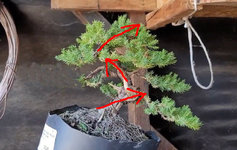
Stylistically, my one observation (not a criticism) is that the lowest two big branches seem to be about the same length and have similar visual masses. I'd consider shortening, thinning, or even jinning one to establish asymmetry and define the directional movement.
For example, by reducing the left branch in this perspective, the movement is clearly shifted to the right (then returns left and moves right again in the apex). In three dimensions, this may or may not work. Just an idea!

Last edited:
Similar threads
- Replies
- 2
- Views
- 2K
- Replies
- 3
- Views
- 460

